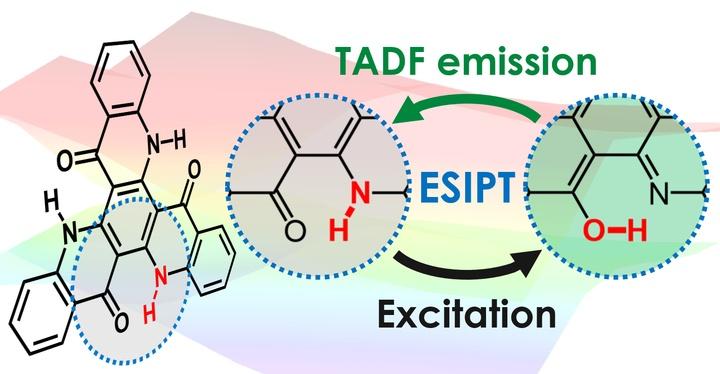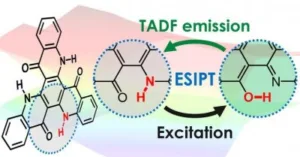Researchers at Kyushu University’s Center for Organic Photonics and Electronics Research (OPERA) demonstrated that a molecule that slightly changes its chemical structure before and after emission can achieve a high efficiency in OLEDs.
“Many new TADF molecules are being reported each month, but we keep seeing the same underlying design with electron-donating groups connected to electron-accepting groups,” says Masashi Mamada, lead researcher on the study reporting the new results.
“Finding fundamentally different molecular designs that also exhibit efficient TADF is a key to unlocking new properties, and in this case, we found one by looking at the past with a new perspective.”
The mechanism explored by the researchers this time involves the reversible transfer of a hydrogen atom – technically, just its positive nucleus – from one atom in the emitting molecule to another in the same molecule to create an arrangement conducive to TADF.
This transfer occurs spontaneously when the molecule is excited with optical or electrical energy and is known as excited-state intramolecular proton transfer (ESIPT).
This ESIPT process is so important in the investigated molecules that quantum chemical calculations by the researchers indicate that TADF is not possible before transfer of the hydrogen.
After excitation, the hydrogen rapidly transfers to a different atom in the molecule, leading to a molecular structure capable of TADF.
The hydrogen transfers back to its initial atom after the molecule emits light, and the molecule is then ready to repeat the process.
Although TADF from an ESIPT molecule has been reported previously, this is the first demonstration of highly efficient TADF observed inside and outside of a device.
 Excited-state intramolecular proton transfer (ESIPT) makes possible organic light-emitting diodes (OLEDs) that are highly efficient by creating the necessary conditions to enable thermally activated delayed fluorescence (TADF). After excitation of the emitting molecule, a hydrogen atom — technically, just its nucleus — is transferred to a different atom in the same molecule through a process called ESIPT. The reconfigured molecule can then undergo TADF to convert a high fraction of the excitations into light. Following emission, the molecule returns to its original state. This mechanism increases the molecular design strategies available for the creation of novel and improved light-emitting materials.
Excited-state intramolecular proton transfer (ESIPT) makes possible organic light-emitting diodes (OLEDs) that are highly efficient by creating the necessary conditions to enable thermally activated delayed fluorescence (TADF). After excitation of the emitting molecule, a hydrogen atom — technically, just its nucleus — is transferred to a different atom in the same molecule through a process called ESIPT. The reconfigured molecule can then undergo TADF to convert a high fraction of the excitations into light. Following emission, the molecule returns to its original state. This mechanism increases the molecular design strategies available for the creation of novel and improved light-emitting materials.
The molecule the researchers used was most likely a disappointment when first synthesized nearly 20 years ago by chemists hoping to create a new pigment only to discover that the molecule is colorless.
“Organic molecules never cease to amaze me,” says Professor Chihaya Adachi, Director of OPERA. “Many paths with different advantages and disadvantages exist for achieving the same goal, and we have still only scratched the surface of what is possible.”
The advantages of this design strategy are just beginning to be explored, but one particularly promising area, the group said, is related to stability. Molecules similar to the investigated one are known to be highly resistant to degradation, so researchers hope that these kinds of molecules might help to improve the lifetime of OLEDs. To see if this is the case, tests are now underway.
Interestingly, the molecule the researchers used was most likely a disappointment when first synthesized nearly 20 years ago by chemists hoping to create a new pigment only to discover that the molecule is colorless.
“Organic molecules never cease to amaze me,” says Professor Chihaya Adachi, Director of OPERA. “Many paths with different advantages and disadvantages exist for achieving the same goal, and we have still only scratched the surface of what is possible.”
The advantages of this design strategy are just beginning to be explored, but one particularly promising area is related to stability.
Molecules similar to the investigated one are known to be highly resistant to degradation, so researchers hope that these kinds of molecules might help to improve the lifetime of OLEDs.
To see if this is the case, tests are now underway.
For more information about this research, see “Highly efficient thermally activated delayed fluorescence from an excited-state intramolecular proton transfer system,” Masashi Mamada et al., ACS Central Science (2017), DOI: 10.1021/acscentsci.7b00183.
Analyst Comment
Kyulux, which develops commercial TADF materials, is based on work done at the Kyushu University. (BR)

